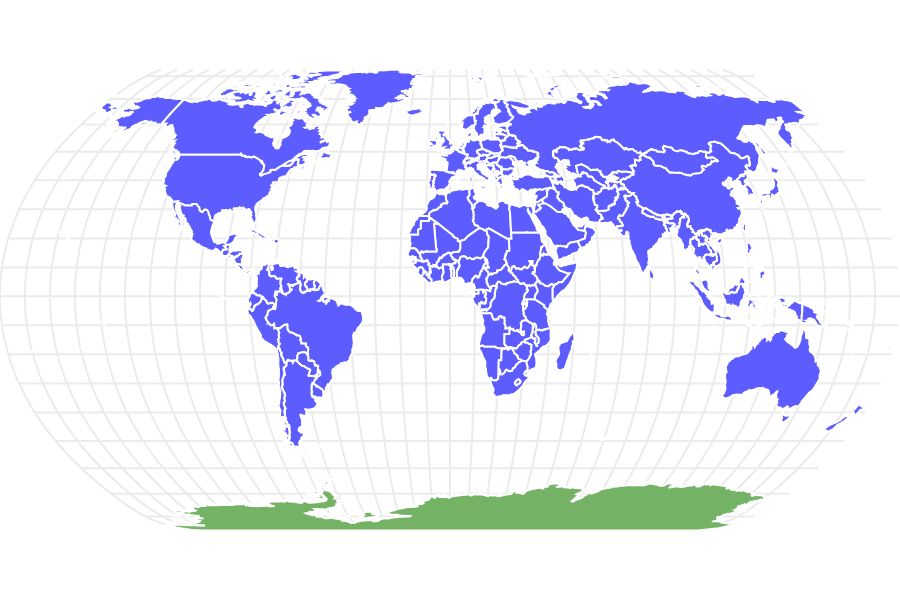Beetle
There are more than 350,000 different species
Advertisement
Beetle Scientific Classification
Read our Complete Guide to Classification of Animals.
Beetle Conservation Status
Beetle Facts
View all of the Beetle images!
“The beetle form the largest order of animals on Earth”
According to biologists, there are at least 400,000 species or types of beetle, all belonging to the Coleoptera order, the Endopterygota suborder, and a great variety of lower classifications. These insects make up one-quarter of all animal lifeforms, and most insects. They are found all over the world save in the oceans, Antarctica and the Arctic even though there are species built to withstand intense cold and others are at least semi-aquatic.
Some are terrible pests, and some are beneficial. Though many are black or brown, others sport beautiful colors and patterns, with metallic or iridescent carapaces. They range from the smallest, Scydosella musawasensis to the largest, the Hercules beetle, which can grow to over 7 inches long.
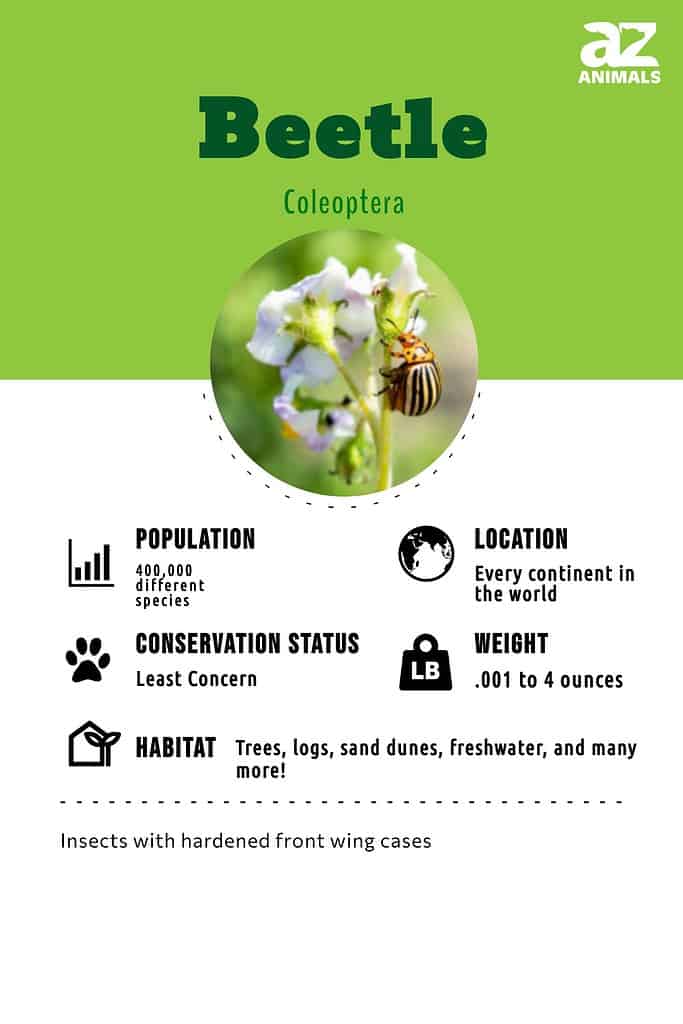
4 Incredible Beetle Facts!
- There are about 300 types of beetles that are eaten by humans, usually in the larval stage.
- These insects evolved around 270 million years ago.
- Though bug is the generic name for all kinds of insects; beetles, and bugs are different. Beetles have hard forewings or elytra, and their mouthparts are made for chewing. The exception to this is the blister beetles, which also have sucking tubes. The mouthparts of bugs are made for sucking and piercing.
- The larvae of beetles can be told by other insect larvae because their heads are hard and often black. They have chewing mouthparts and spiracles, or tiny holes that allow them to breathe along their sides. Some are called grubs. Grubs eat organic material and are the root of grasses and plants.
Species, Types, and Scientific Name
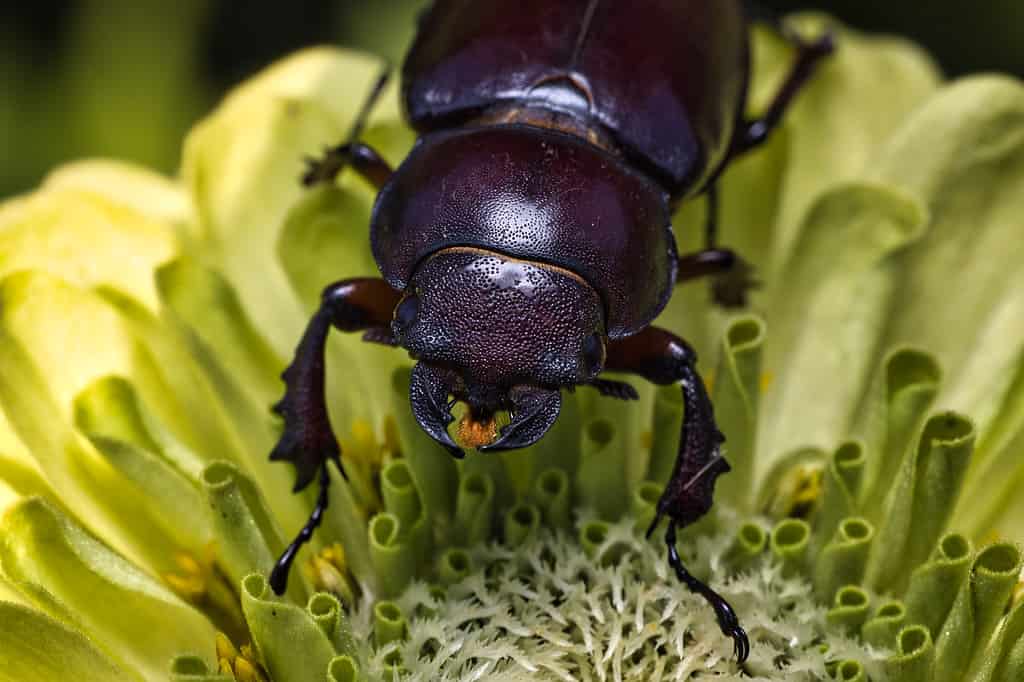
This lovely fellow is a stag beetle.
©John Reed Pavan/Shutterstock.com
Coleoptera comes from the Greek words for “sheath” and “wing” because of the insect’s tough forewings. The lower classifications for Coleoptera are not only very numerous but complicated, with families and superfamilies and suborders based on what the animal eats and even tiny structures on its head, its mouthparts, or its hind legs. Here are some of the more populous families, superfamilies, suborders, infraorders, and tribes:
Adephaga, whose lower classifications include Hydradephaga and Geadephaga, with 5560 and 35,000 species, respectively, and include the diving and ground beetles. The Polyphaga order has the most species. Families in Polyphaga include Staphylinidae, with 48,000 species, and Scarabaeoidea, with 35,000 species, including those that encompass scarabs. Other families include the Elateroidea, with 23,000 species, and the Tenebrionoidea, with 35,000 species. The superfamily Chrysomeloidea contains the Chrysomelidae, Cerambycidae, and Curculionoidea families. These families have 35,000, 25,000, and 97,000 species, respectively, and include the weevils.
The scientific name for some popular beetles are:
- Asian lady beetle: One of the most familiar ladybugs, Harmonia axyridis, belongs to the Coccinellidae family.
- Hercules beetle: Dynastes hercules is a member of the Scarabaeidae family.
- Giant stag beetle: Lucanus elaphus belongs to the Lucanidae family.
- Green June bug: This large insect with the bright green carapace is not a bug, but a beetle. Its scientific name is Cotinis nitida, and it belongs to the Scarabaeidae family and the Cetoniinae subfamily.
- Common eastern firefly: This insect is a beetle, not a fly, and its scientific name is Photinus pyralis. It belongs to the Lampyridae family and the Photinini tribe.
- Arizona golden tortoise beetle: This little insect, Physonota arizonae, looks like it’s made out of a drop of molten gold. It belongs to the Polyphaga suborder.
Evolution and Origins
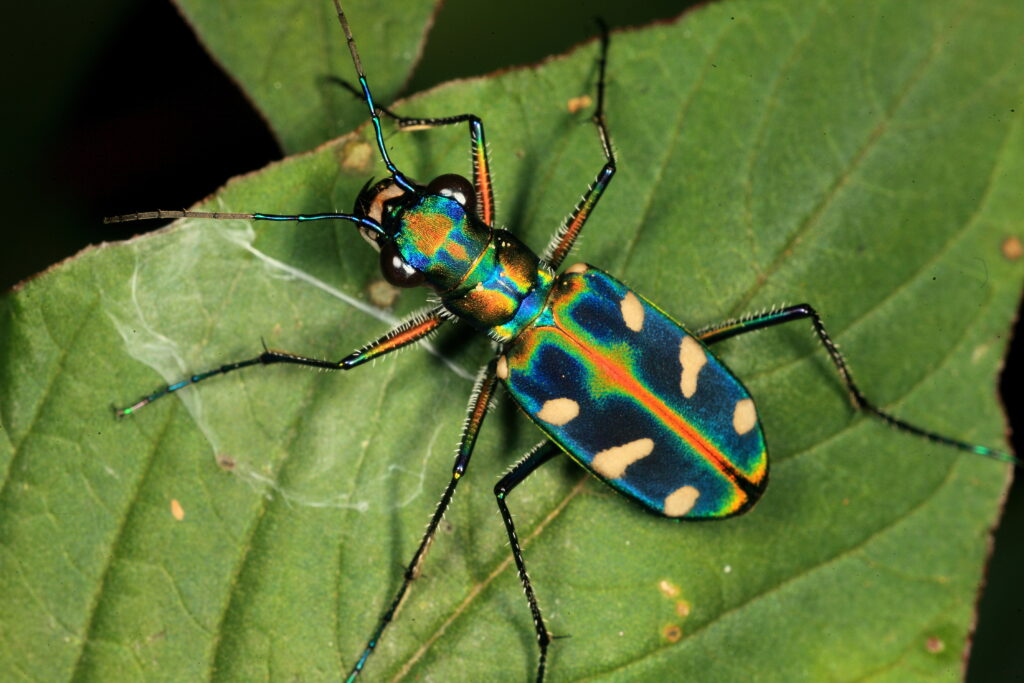
Tiger
beetles live in sandy areas near the beach.
©wagtail/Shutterstock.com
People can find beetles in many different habitats, from parks to rainforests and tundra. There are almost 400 thousand species of beetles, making them the most varied animal species on earth. This abundance has perplexed scientists for a long time. Charles Darwin and Alfred Russel Wallace were two of the many to use beetles to develop theories about evolution. However, understanding the evolution and origins of beetles is difficult. A research team used a 68-gene dataset and 57 fossils to construct an evolutionary tree of beetles. The results indicate that various beetle groups expanded as new ecological opportunities became available.
It appears that the success of beetles is due to their remarkable adaptability, as there was not one single moment in which their evolution began. A new timeline of beetle development will provide a better understanding of how this species has become so successful. Recent research and analysis have identified 193 existing and extinct beetle families, with the oldest fossils being 295 million years old – before dinosaurs even roamed the earth.
In order to gain insight into the huge variety of beetles in the world today, researchers have studied their genetics, physical features, and rare fossils to trace back their evolutionary history. It has been concluded that beetles first appeared during the Carboniferous period and later diversified alongside dinosaurs during the Triassic and Jurassic periods.
Appearance: How To Identify Them
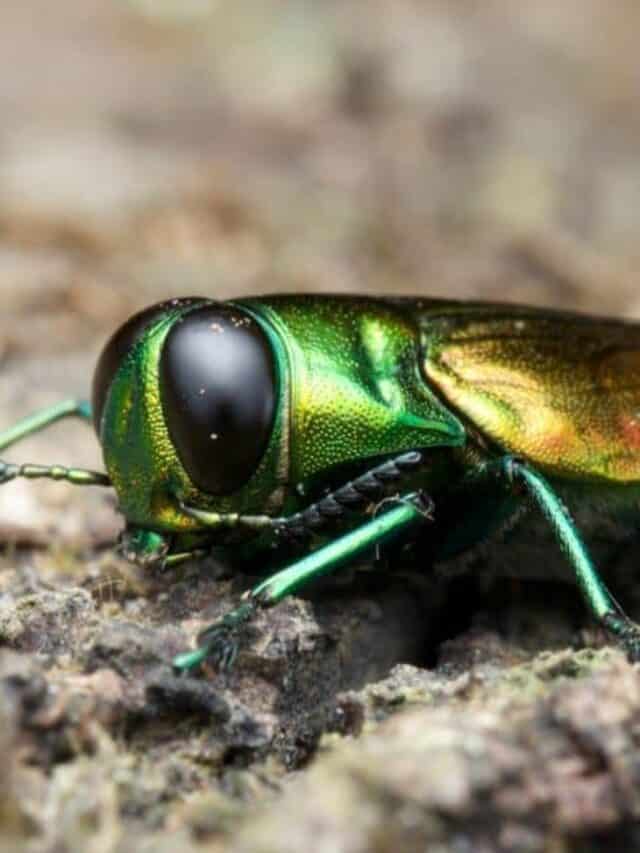
The Emerald Ash Borer, a type of beetle, eats tissue under the bark of ash trees.
©Herman Wong HM/Shutterstock.com
Adults always have wings, and their front wings are hard and are not used for flying. Instead, they are used to cover the hind wings, which are used for flying. When they close, they form a straight line down the back. The forewings extend all the way to the back of the abdomen. If they don’t extend to the back of the abdomen, the insect is considered a true bug.
The body can be long, cylindrical, round, half-round, or flat with chewing mouthparts. They can come in shades of black or brown, but many are brilliantly colored. Their antennae almost always have 11 segments but can be short or longer than the body. They have large and well-developed compound eyes, and their legs have evolved for the insect to run, jump, swim, grasp, and dig.
The larvae live in the ground or bore into dead or live wood, roots, or seeds. Some eat other invertebrates, carrion, rotting vegetation, or fungi and pupate in the soil, in wood, or under decaying bark. Most don’t spin a cocoon. Some larvae are parasitic and live on or in a live host.
Most beetles don’t live more than a year, but some can take more than a year to pupate. Adults are attracted to lights at night and can be easily found on plants during the day.
Population and Distribution
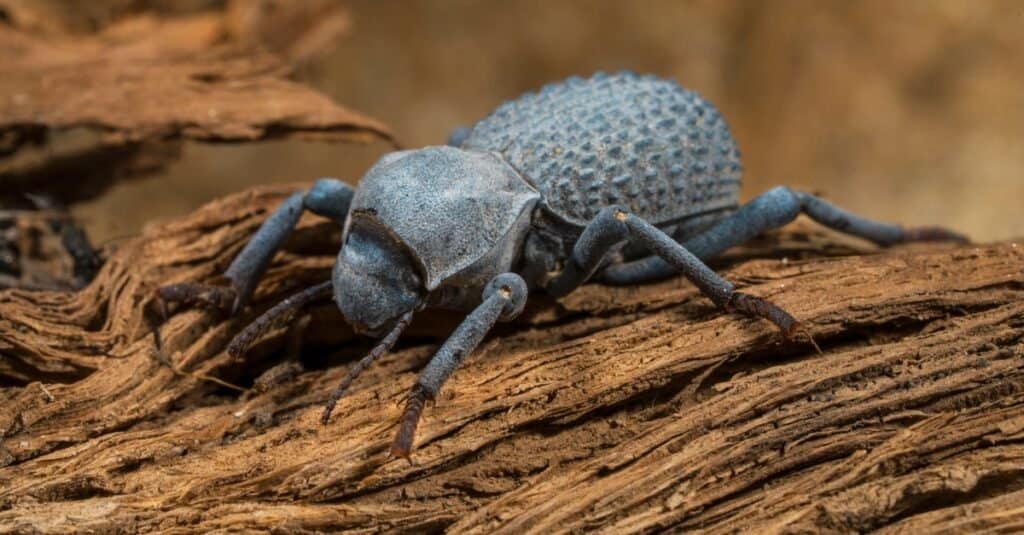
Asbolus verrucosus (desert ironclad beetles or blue death-feigning
beetles) beetle on desert driftwood.©GypsyPictureShow/Shutterstock.com
Beetles are actually the largest order of insects. In fact, around 400,000 different species make up about 40% of all insect species. A study in 2015 states that four independent estimates of the number of beetle species give it around 1.5 million, with a narrow range spanning all four estimates. There are an estimated 2.1 million different types of beetles. Which, in layman’s terms, means there are more beetles than any other species of insect.
Beetles are found in almost all habitats, including freshwater and coastal areas. Anywhere where there is vegetation, you will find beetles living in bark, flowers, and leaves. The heaviest of beetles in the insect stage is the larva of the goliath beetle, which can attain a mass of just over 4 oz with a length of about 5 inches long.
Habitat
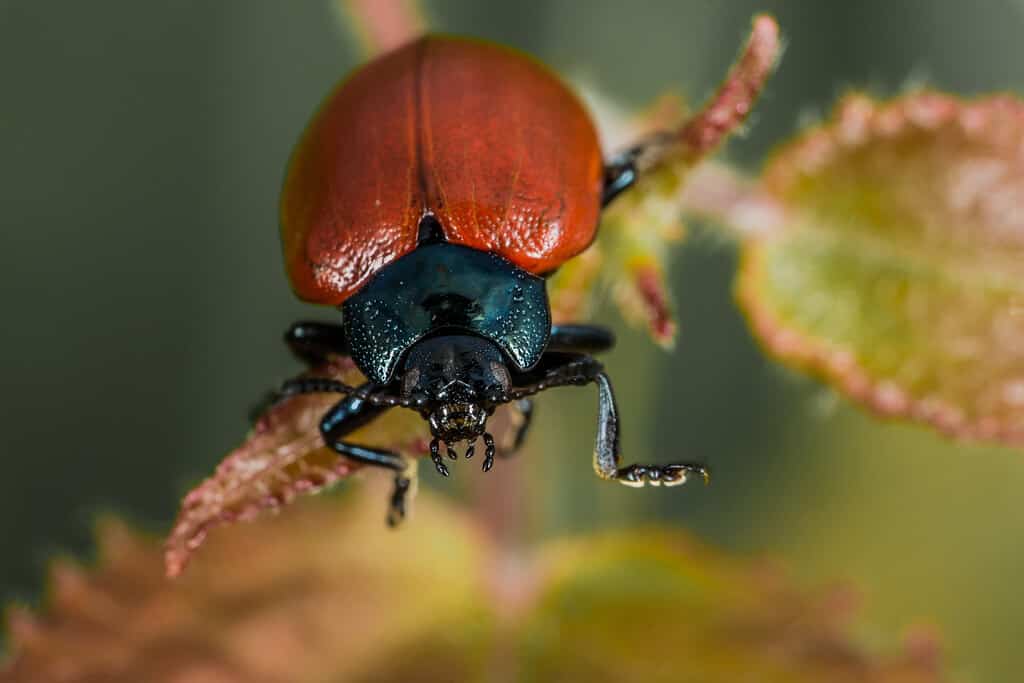
Of all the beetles native to Arizona, the cottonwood is one of the more visually stunning.
©Sebastian Fachbach/Shutterstock.com
These insects can be found just about anywhere. Even a cursory glance at a tree or a shrub or plant will disclose some kind of beetle, which may be actively eating the plant or simply resting on it. They are found under rocks, under old bark, in rotting logs, and in dung heaps. They are found in and around food, clothing, rugs, carpets, and upholstery. If a porch light is turned on, they will come flying to it.
Aquatic beetles are mostly found in freshwater, though some of them do live in shallow waters near the shore. The adults often carry an air bubble or have a modification to their exoskeleton to allow them to breathe underwater.
Diet
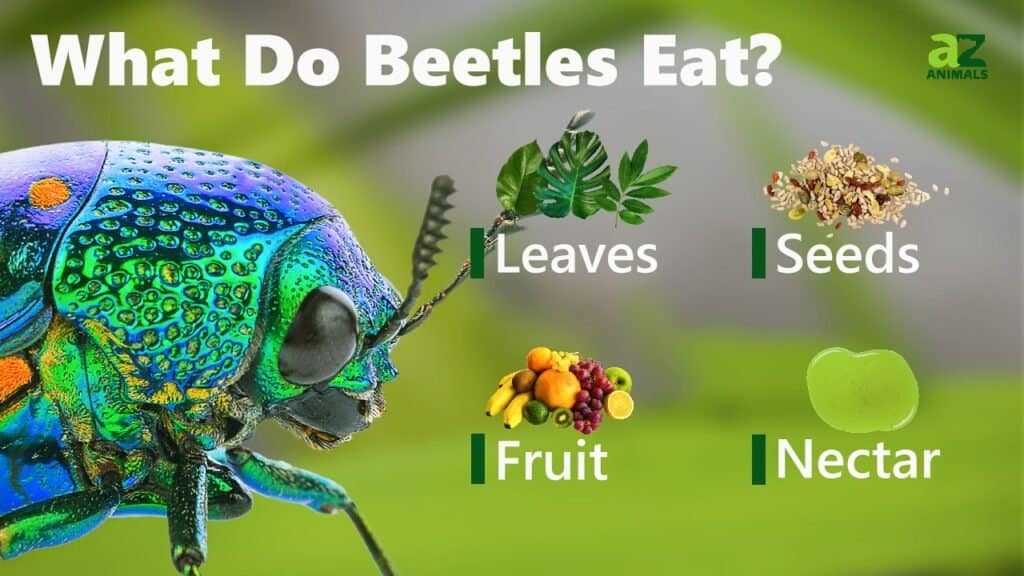
The materials these insects eat nearly defy listing. Some only eat plant materials. Others are scavengers, and some are omnivores. Some restrict themselves to only one type of plant, while others are hunters that prey on other insects, spiders, snails, and earthworms. Others eat dung and carrion, while others eat beetles that eat dung and carrion. Many beetles rely on the presence of fungi in their gut to help them digest their food. Weevils eat plant parts, flour, and grains.
Prevention: How to Get Rid of Them
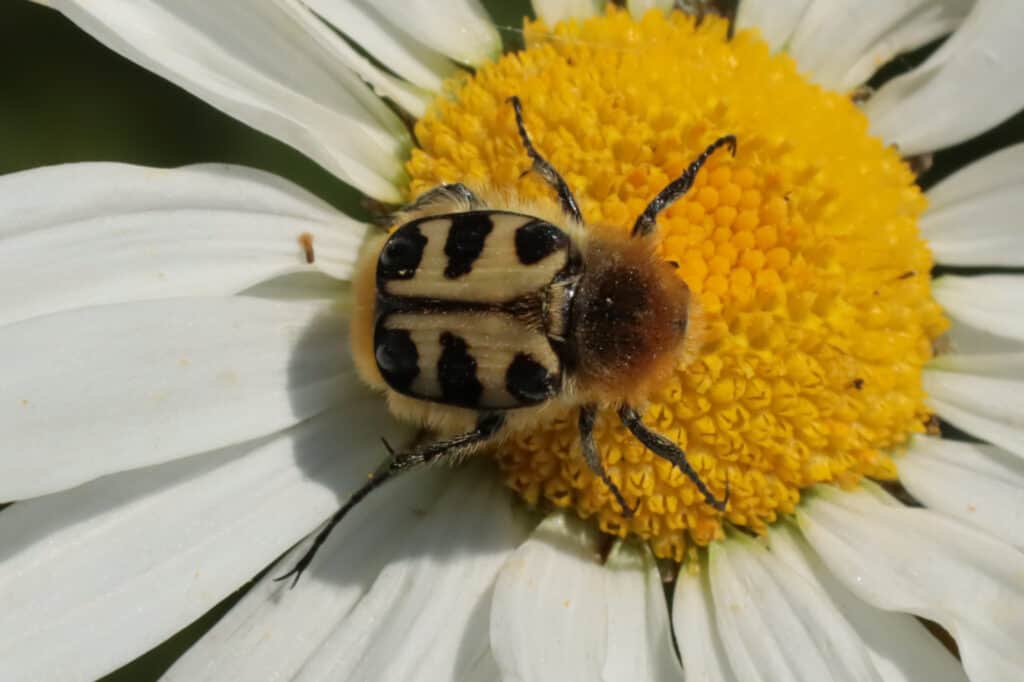
Bee beetles are found in gardens, meadows, and flowery areas, particularly around roses and thyme flowers.
©iStock.com/DE1967
There are many ways of getting rid of beetle pests. They can simply be plucked from host plants and squashed or dropped into soapy water. They can be dusted with insecticidal powder, even though this will cause some collateral damage to insects such as butterflies and ladybugs. Their grubs can be exposed to nematodes or parasitic wasps. Sometimes controlling beetles is drastic. Lumber may need to be quarantined and treated with insecticide if it’s feared it is harboring pests. Sometimes forests full of trees need to be cut down and burnt to stop an invasion of a wood-boring beetle.
View all 285 animals that start with BBeetle FAQs (Frequently Asked Questions)
Are Beetles herbivores, carnivores, or omnivores?
Beetles are Omnivores, meaning they eat both plants and other animals.
What Kingdom do Beetles belong to?
Beetles belong to the Kingdom Animalia.
What phylum do Beetles belong to?
Beetles belong to the phylum Arthropoda.
What class do Beetles belong to?
Beetles belong to the class Insecta.
What type of covering do Beetles have?
Beetles are covered in Shells.
Where do Beetles live?
Beetles are found worldwide.
In what type of habitat do Beetles live?
Beetles live in most land and freshwater habitats.
What is the main prey for Beetles?
Beetles prey on insects, dust, and dung.
What are some predators of Beetles?
Predators of Beetles include bats, frogs, and reptiles.
What is the average litter size for a Beetle?
The average litter size for a Beetle is 200.
What is an interesting fact about Beetles?
There are more than 350,000 different species of Beetle!
How many species of Beetle are there?
There are 350,000 species of Beetle.
How do you get rid of a Japanese beetle?
There are several ways to get rid of Popillia japonica. One way is to dust it with an insecticide, though that risks killing beneficial insects who may land on the same plant. A more targeted way is to simply shake them off of a plant into a bowl of soapy water. This kills them instantly. A pre-emergent insecticide can also be applied to the area around the plants. This kills Japanese beetle grubs that live in the ground. Birds such as cardinals and jays readily feed on Japanese beetles, so they should be encouraged to visit the area through setting up bird baths and feeding stations.
Are beetles harmful?
Some are harmful, especially to plants. The cotton boll weevil, for example, causes farmers hundreds of millions of dollars in lost cotton plants.
Why do I have beetles in my house?
Beetles enter a house because they can find food and shelter, and they have found a way to get in. They can come in through the tiniest crack, through an open door or window or can be transported in groceries, furniture or on clothing.
Can a beetle kill you?
Beetles don’t kill humans, though some may bite if they feel threatened. Blister beetles release a toxin called Cantharidin, which can raise blisters on the skin, and the Onychocerus albitarsis is the only beetle with a sting, but the discomfort from the sting is temporary. But overall, these insects are mostly dangerous to plants and other invertebrates.
Why are beetles bad?
Not all beetles are bad, but those considered “bad” damage plants that people want and need, including garden plants, trees and crops.
How do you get rid of carpet beetles?
Though adults are harmless, their presence in a house means larvae are probably present. Larvae are the ones that eat the fibers and do the damage. Fortunately, there are several ways to get rid of them. The area where they’re found can be dusted with boric acid, which isn’t hazardous to humans or pets in small amounts or diatomaceous earth, which is harmless. The dust can be swept into the material with a brush, left to sit for a couple of hours then vacuumed up.
Carpet beetles can also be deterred by sprayed-on insecticides such as bifenthrin or simply being sprayed with vinegar. Frequent vacuuming also keeps these pests under control.
What are the key differences between beetles and bugs?
The greatest differences between beetles and bugs can be found in their phylogenetic families as well as their metamorphoses. Specifically, beetles are from the Coleoptera order of the Insecta class, but bugs are from the Hemiptera order of the Insecta class.
How to say Beetle in ...
Thank you for reading! Have some feedback for us? Contact the AZ Animals editorial team.
Sources
- Bon Vila, Available here: https://www.bobvila.com/articles/how-to-get-rid-of-carpet-beetles/
- Discover, Available here: https://www.discovermagazine.com/planet-earth/natural-antifreeze-keeps-beetles-unfrozen
- Science Direct, Available here: https://www.sciencedirect.com/topics/agricultural-and-biological-sciences/whirligig-beetle
- Wikipedia, Available here: https://en.wikipedia.org/wiki/Beetle
- Texas A & M Agrilife Extension, Available here: https://agrilife.org/urban-ipm/2016/04/29/beetle-or-true-bug/

